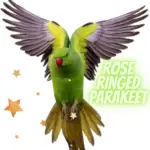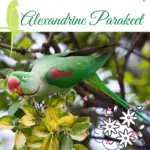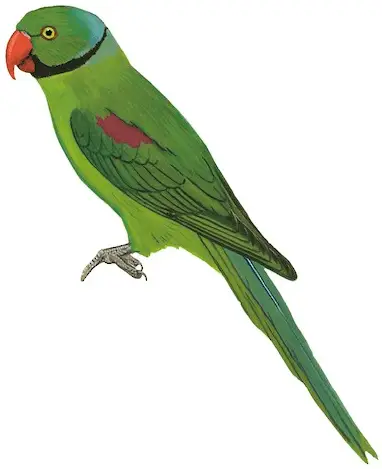Seychelles parakeet ( Psittacula wardi ) is an extinct species of parrot in the noble parakeet genus. It was endemic to Seychelles. The species epithet refers to Swinburne Ward, the British civil commissioner in Seychelles from 1862 to 1868.
Systematics History
Phylogenetic studies suggest that this species diverged from P. eupatria. Monotypic.
Subspecies
Although evidently common in the early years of the 19th century, the last specimen was shot on Mahé in 1893. The species may have survived into the 20th century, but was apparently extinct by the time Nicoll visited Mahé in 1906.
The main causes of its demise seem to have been forest clearance (for coconut plantations) and, especially, shooting and trapping, in particular, to protect maize (Zea mays) crops.
Distribution
Seychelles: Mahé and Silhouette, with a sight record from Praslin. At least ten specimens exist.
Classification
The Seychelles parakeet has often been considered a subspecies of the Alexandrine Parakeet ( Psittacula euphoria ) because of the similar nuchal band.
However, it is not known whether there is actually a close relationship with Alexander’s parakeet since no skeleton of the Seychelles parakeet exists and DNA analysis of the existing museum material was never carried out.
Personality
The length of the Seychelles Parrot reached 41 cm. The head of the male was green. The back of the head and neck were washed blue.
The chin and an indistinct line between the eyes and cere were black, as was a wide cheekbone running from beak to buttock. The belly was greenish-yellow. There was a purplish-red spot on the elytra.
The top of the middle tail feathers was blue with yellowish tips. The outer tail feathers were green. The undercoverts of the tail were yellowish. Its beak was red with a yellow tip. The iris was yellowish. The feet were grey.
The female looked similar to the male. It differed in the absence of the black cheek stripe as well as in the completely black beak coloring.
The Seychelles Parakeet was smaller and had a more powerful beak than the Alexandrine Parakeet. Other distinguishing features were the crimson shoulder patches and the absence of the pink nape band.
Distribution
The Seychelles parakeet was found on the islands of Mahé, Silhouette, and probably also on Praslin.
Extinction
Edward Newton noticed that the Seychelles parrot was on the verge of extinction, in 1867 when it was first scientifically described.
In March 1880 and June 1881, the bird collector HM Warry shot the last three specimens recorded in the wild (two females and one juvenile male).
The last known specimen died in human care on Silhouette Island in 1883. When the British ornithologist Michael John Nicoll visited Seychelles in 1906, he could no longer identify any specimen.
The forests where the species once existed have given way to coconut plantations. In addition, the parakeets were shot by the farmers because they were causing damage to the cornfields. A total of ten copies exist in museum collections.
SOURCE: maclaine1138





















